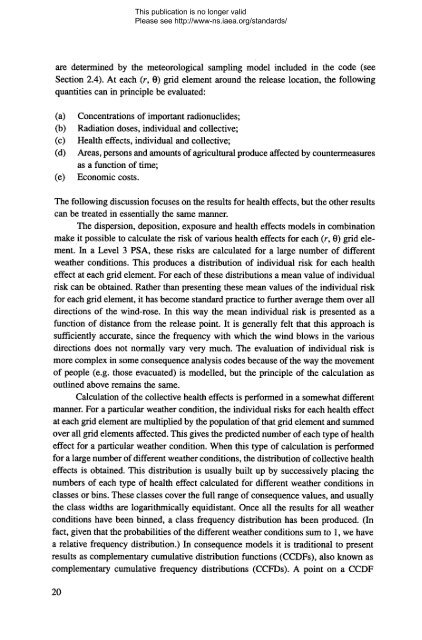LEVEL 3 - gnssn - International Atomic Energy Agency
LEVEL 3 - gnssn - International Atomic Energy Agency
LEVEL 3 - gnssn - International Atomic Energy Agency
You also want an ePaper? Increase the reach of your titles
YUMPU automatically turns print PDFs into web optimized ePapers that Google loves.
This publication is no longer valid<br />
Please see http://www-ns.iaea.org/standards/<br />
are determined by the meteorological sampling model included in the code (see<br />
Section 2.4). At each (r, 0) grid element around the release location, the following<br />
quantities can in principle be evaluated:<br />
(a)<br />
(b)<br />
(c)<br />
(d)<br />
(e)<br />
Concentrations of important radionuclides;<br />
Radiation doses, individual and collective;<br />
Health effects, individual and collective;<br />
Areas, persons and amounts of agricultural produce affected by countermeasures<br />
as a function of time;<br />
Economic costs.<br />
The following discussion focuses on the results for health effects, but the other results<br />
can be treated in essentially the same manner.<br />
The dispersion, deposition, exposure and health effects models in combination<br />
make it possible to calculate the risk of various health effects for each (r, 0) grid element.<br />
In a Level 3 PSA, these risks are calculated for a large number of different<br />
weather conditions. This produces a distribution of individual risk for each health<br />
effect at each grid element. For each of these distributions a mean value of individual<br />
risk can be obtained. Rather than presenting these mean values of the individual risk<br />
for each grid element, it has become standard practice to further average them over all<br />
directions of the wind-rose. In this way the mean individual risk is presented as a<br />
function of distance from the release point. It is generally felt that this approach is<br />
sufficiently accurate, since the frequency with which the wind blows in the various<br />
directions does not normally vary very much. The evaluation of individual risk is<br />
more complex in some consequence analysis codes because of the way the movement<br />
of people (e.g. those evacuated) is modelled, but the principle of the calculation as<br />
outlined above remains the same.<br />
Calculation of the collective health effects is performed in a somewhat different<br />
manner. For a particular weather condition, the individual risks for each health effect<br />
at each grid element are multiplied by the population of that grid element and summed<br />
over all grid elements affected. This gives the predicted number of each type of health<br />
effect for a particular weather condition. When this type of calculation is performed<br />
for a large number of different weather conditions, the distribution of collective health<br />
effects is obtained. This distribution is usually built up by successively placing the<br />
numbers of each type of health effect calculated for different weather conditions in<br />
classes or bins. These classes cover the full range of consequence values, and usually<br />
the class widths are logarithmically equidistant. Once all the results for all weather<br />
conditions have been binned, a class frequency distribution has been produced. (In<br />
fact, given that the probabilities of the different weather conditions sum to 1, we have<br />
a relative frequency distribution.) In consequence models it is traditional to present<br />
results as complementary cumulative distribution functions (CCDFs), also known as<br />
complementary cumulative frequency distributions (CCFDs). A point on a CCDF<br />
20

















